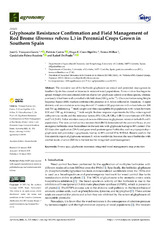Glyphosate Resistance Confirmation and Field Management of Red Brome (Bromus rubens L.) in Perennial Crops Grown in Southern Spain
Autor
Vázquez-García, José Guadalupe
Castro, Patricia
Cruz Hipólito, Hugo E.
Millán, Teresa
Palma-Bautista, Candelario
Prado, Rafael de
Editor
MDPIFecha
2021Materia
Bromus spp.Glyphosate resistance
Integrated weed management
Crop protection
METS:
Mostrar el registro METSPREMIS:
Mostrar el registro PREMISMetadatos
Mostrar el registro completo del ítemResumen
The excessive use of the herbicide glyphosate on annual and perennial crops grown in Southern Spain has caused an increase in resistant weed populations. Bromus rubens has begun to spread through olive and almond cultivars due to low glyphosate control over these species, whereas previously it had been well controlled with field dose (1080 g ae ha−1). Characterization using Simple Sequence Repeat (SSR) markers confirmed the presence of B. rubens collected in Andalusia. A rapid shikimic acid accumulation screening showed 17 resistant (R) populations with values between 300 and 700 µg shikimate g−1 fresh weight and three susceptible (S) populations with values between 1200 and 1700 µg shikimate g−1 fresh weight. In dose–response experiments the GR50 values agreed with previous results and the resistance factors (RFs: GR50 R/GR50 S (Br1)) were between 4.35 (Br9) and 7.61 (Br19). Foliar retention assays shown no differences in glyphosate retention in both R and S populations. The tests carried out in a resistant field (Br10) demonstrated the control efficacy of pre-emergence herbicides since flazasulfuron in the tank mix with glyphosate had up to 80% control 15 to 120 days after application (DAA) and grass weed postemergence herbicides, such as propaquizafop + glyphosate and quizalofop + glyphosate, had up to 90% control 15 to 90 DAA. Results confirm the first scientific report of glyphosate-resistant B. rubens worldwide; however, the use of herbicides with another mode of action (MOA) is the best tool for integrated weed management.

